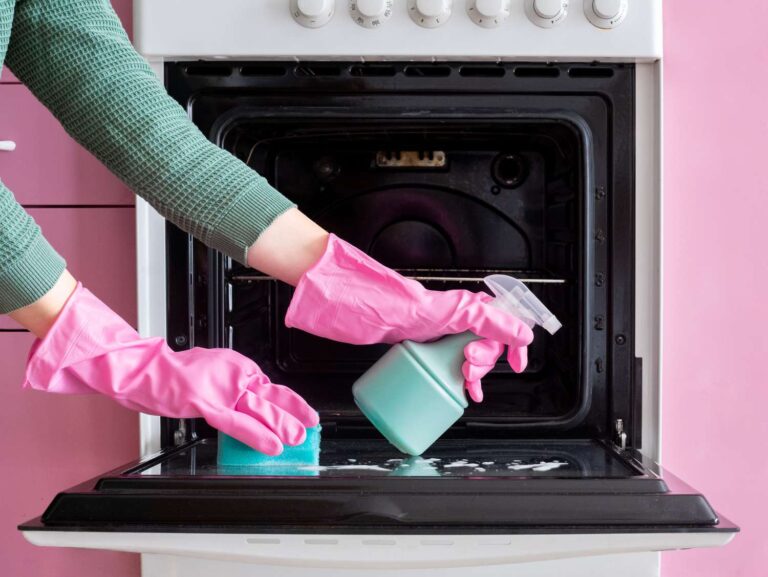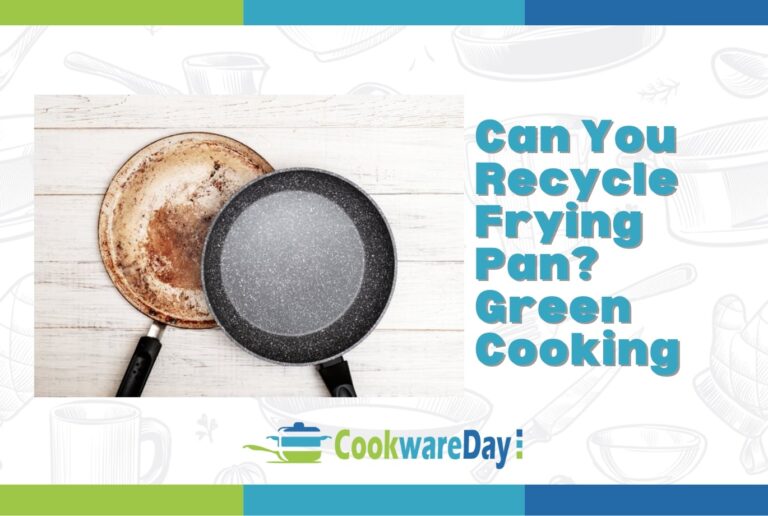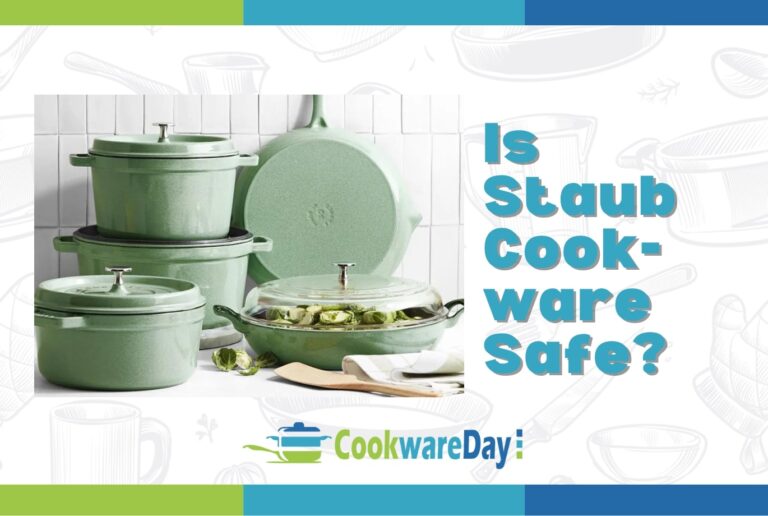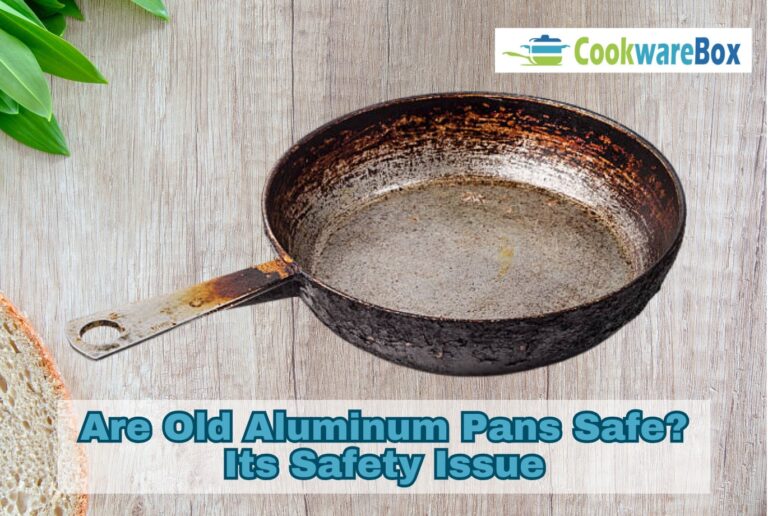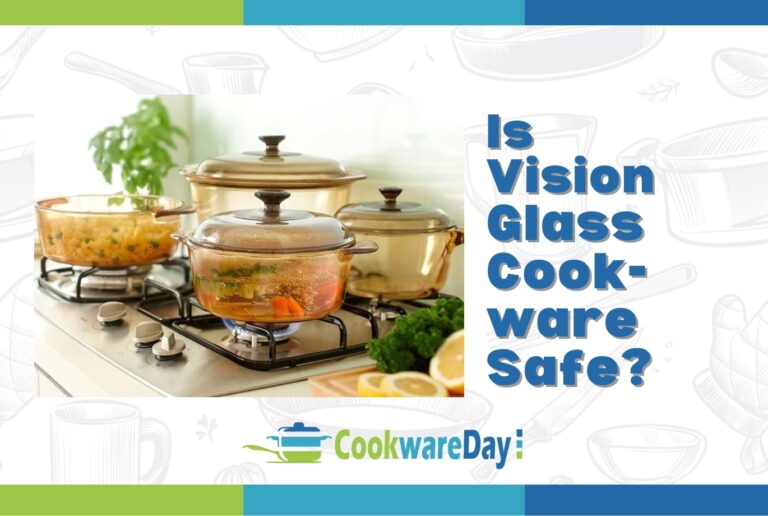Is Calphalon Cookware Safe? Safety & Quality

When it comes to cookware, safety is a top priority. After all, you want to ensure that the pots and pans you use to prepare your meals are not only effective but also safe for you and your family. Calphalon has long been a trusted name in the world of cookware, known for its high-quality products. But is Calphalon cookware safe?
In this blog post, we’ll take a closer look at the safety features of Calphalon cookware and address any concerns you may have. So if you’re in the market for new cookware or simply curious about the safety of your current set, keep reading to find out more.
Is Calphalon Cookware Safe?
Alphalon cookware is generally safe for use in cooking. The brand’s products are known for their high-quality and durable construction, making them a popular choice among professional chefs and home cooks alike.
Calphalon is a well-known brand of cookware, and the safety of using their products largely depends on the specific type of cookware and how you use and care for it. Calphalon offers various lines of cookware, including nonstick, stainless steel, and hard-anodized aluminum cookware. Here’s a general overview of the safety considerations for each type:
- Nonstick Cookware: Calphalon’s nonstick cookware is coated with a layer of PTFE (polytetrafluoroethylene), which is commonly known as Teflon. When used and cared for properly, nonstick cookware is safe for cooking. However, it’s important to avoid overheating nonstick pans, as high temperatures can cause the nonstick coating to release potentially harmful fumes. Scratching or damaging the nonstick coating can also lead to health concerns, as it may cause the release of particles into your food. Be sure to follow the manufacturer’s instructions for proper use and care.
- Stainless Steel Cookware: Calphalon’s stainless steel cookware is generally considered safe for cooking. Stainless steel is a non-reactive material, which means it won’t leach any harmful chemicals into your food. Just be mindful of using the appropriate cooking techniques and temperatures for stainless steel to prevent food from sticking to the pan.
- Hard-Anodized Aluminum Cookware: Calphalon’s hard-anodized aluminum cookware is also considered safe for cooking. Anodization is a process that creates a hard, non-reactive surface on the aluminum, preventing it from reacting with or leaching into your food. This type of cookware is durable and distributes heat evenly.
In summary, Calphalon cookware is safe to use as long as you follow the manufacturer’s instructions and use it appropriately. Pay attention to the type of cookware you have and its specific care recommendations. If you use nonstick cookware, avoid overheating it and be cautious not to damage the nonstick coating. With proper care and maintenance, Calphalon cookware can provide safe and reliable cooking results.
Understanding Calphalon Cookware
Understanding Calphalon Cookware Materials
When it comes to choosing the right cookware for your kitchen, the materials used play a crucial role. Calphalon, a renowned brand in the cookware industry, offers a wide range of products with different materials. Understanding Calphalon cookware materials is essential in ensuring you make informed decisions about the safety and performance of your cooking utensils.
Different materials used in Calphalon cookware
Calphalon cookware is available in various materials, each with its unique properties and benefits. Here are some commonly used materials:
1. Nonstick Hard-Anodized Aluminum:
This material is a popular choice for Calphalon cookware due to its excellent heat distribution and durability. The surface is treated with a nonstick coating, which makes it easier to cook and clean. Additionally, the hard-anodized aluminum provides superior strength and resistance to warping.
2. Stainless Steel:
Calphalon also offers cookware made of stainless steel, which is known for its durability and corrosion resistance. Stainless steel cookware is versatile and can be used for various cooking methods. It is a great option for those who prefer a sleek, modern look in their kitchen.
Pros and cons of each material
Here’s a closer look at the pros and cons of these Calphalon cookware materials:
Nonstick Hard-Anodized Aluminum:
Pros:
– Excellent heat distribution for even cooking.
– Nonstick surface reduces the need for excess oil or butter, promoting healthier cooking.
– Easy to clean with minimal effort.
– Resistant to scratching and staining.
Cons:
– Nonstick coating may wear off over time and require replacement.
– Limited metal utensil compatibility to prevent scratching.
– Not suitable for high-temperature cooking methods such as broiling or using under a broiler.
Stainless Steel:
Pros:
– Durable and long-lasting material.
– Resistant to rust, corrosion, and warping.
– Compatible with all cooking utensils, including metal ones.
– Can withstand high-temperature cooking methods.
Cons:
– Lacks nonstick properties, making it prone to food sticking.
– Requires proper care to prevent staining and discoloration.
– Uneven heat distribution may result in hot spots if not used correctly.
Evaluating the safety of Calphalon cookware materials
When it comes to cooking utensils, safety is a top priority. Calphalon cookware materials undergo rigorous testing to ensure their safety for everyday use. The nonstick coatings used in their hard-anodized aluminum cookware are engineered to be PFOA-free, ensuring they do not release harmful substances during cooking.
Stainless steel, on the other hand, is a safe and inert material that does not react with food. It is free from any potentially harmful coatings or chemicals that may leach into your meals.
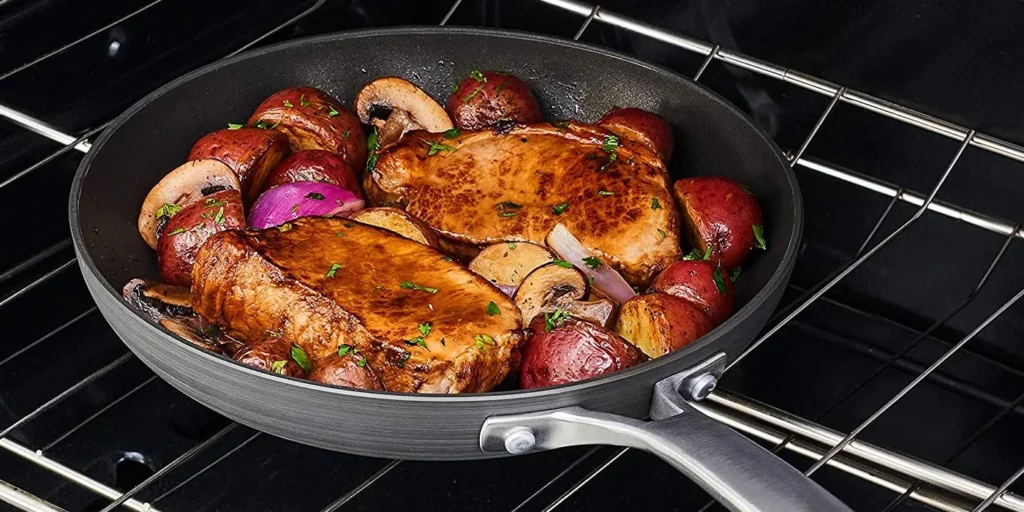
What Makes Cookware Safe or Unsafe?
Before we get into the specifics of Calphalon cookware, let’s discuss the general factors that determine whether cookware is safe or unsafe. These factors can apply to any brand of cookware and are essential to consider when making your selection.
1. Material Composition
The materials used in cookware play a crucial role in its safety. Some materials are more prone to leaching harmful substances into your food, while others are considered inert and safe. Common materials used in cookware include stainless steel, cast iron, nonstick coatings, and more.
2. Coating Integrity
For nonstick cookware, the integrity of the coating is vital. If the nonstick surface starts to peel or degrade, it can release potentially harmful chemicals into your food. Additionally, scratched or damaged coatings can harbor bacteria and affect the overall safety of the cookware.
3. Heat Resistance
Cookware must be able to withstand high temperatures without releasing toxic fumes or warping. The heat resistance of the materials used is crucial for safety during cooking.
4. Reactivity
Some types of cookware can react with certain foods, resulting in off-flavors or discoloration. It’s important to choose cookware that is non-reactive with the foods you commonly prepare.
5. Maintenance and Care
Proper maintenance and care are key to the longevity and safety of your cookware. Neglecting to follow manufacturer’s instructions for cleaning and storage can compromise its safety over time.
What materials are used in Alphalon cookware?
Alphalon cookware is widely recognized for its high-quality construction and excellent heat distribution. To understand the safety of Alphalon cookware, let’s take a closer look at the materials used in its composition.
Alphalon cookware is typically made using a combination of two materials: hard-anodized aluminum and a nonstick coating. Hard-anodized aluminum is known for its durability, heat conductivity, and resistance to corrosion. This material undergoes a special electrochemical process, resulting in a harder surface that is more scratch-resistant than regular aluminum. The nonstick coating used in Alphalon cookware enhances its cooking performance by providing a smooth surface that prevents food from sticking, making it easier to clean.
Analyzing Potential Health Risks
Examining the impact of nonstick coatings on health
One of the primary concerns when it comes to the safety of Calphalon cookware is the potential health risks associated with its nonstick coatings. Calphalon cookware, like many other nonstick cookware brands, uses a coating called Teflon, which contains a chemical compound known as polytetrafluoroethylene (PTFE).
PTFE is generally considered safe at low temperatures, but it can release toxic fumes when overheated. These fumes can potentially cause a condition known as polymer fume fever, which is characterized by symptoms such as fever, chills, and flu-like symptoms. However, it’s important to note that reaching the temperatures required to release these fumes is quite rare in normal cooking scenarios.
To minimize the risks associated with nonstick coatings, it’s crucial to avoid overheating your nonstick cookware. Always use low to medium heat settings when cooking with nonstick pans and avoid preheating them empty as this can lead to overheating. Additionally, using wooden or silicone utensils instead of metal ones can help prevent scratching the nonstick coating, which can also increase the release of potentially harmful compounds into your food.
Understanding the risks associated with overheating cookware
Overheating any type of cookware can pose health risks, not just nonstick pans. When cookware is exposed to high temperatures, it can potentially release chemicals and metals into your food. This can be particularly concerning when it comes to nonstick coatings, as they tend to break down at high temperatures.
In addition to the concerns of releasing toxic fumes, overheated nonstick pans can also develop hotspots that can lead to uneven cooking. These hotspots can burn your food or cause it to stick to the pan, which can potentially expose you to harmful substances.
Calphalon Nonstick Cookware and PTFE
One of the most common concerns about the safety of Calphalon cookware revolves around its nonstick cookware, which uses a PTFE coating. PTFE is often referred to by its brand name, Teflon, and it’s been a subject of safety debates for many years.
The Safety of PTFE:
PTFE itself is considered safe for cooking when used within its recommended temperature range. This temperature range is typically up to 500°F (260°C). At temperatures above this range, PTFE can break down, releasing fumes that can cause temporary flu-like symptoms known as polymer fume fever. It’s worth noting that most cooking occurs at temperatures well below the 500°F threshold, making PTFE safe for everyday cooking.
Proper Use of Nonstick Cookware:
To ensure the safety of Calphalon nonstick cookware and any other brand using PTFE, it’s important to follow these guidelines:
- Avoid high heat: Never heat nonstick cookware above 500°F (260°C).
- Use low to medium heat: Most cooking can be done effectively at lower temperatures.
- Avoid metal utensils: Use utensils made of wood, silicone, or plastic to prevent scratching the nonstick coating.
- Replace damaged cookware: If the nonstick coating becomes scratched or damaged, it’s best to replace the cookware to maintain safety.
Alternatives to PTFE:
If you have concerns about using PTFE-coated cookware, you can explore alternatives such as ceramic nonstick cookware or stainless steel. These options don’t rely on PTFE for their nonstick properties and may provide peace of mind for those who want to avoid PTFE altogether.
Calphalon’s Commitment to Safety
Calphalon is committed to providing safe and high-quality cookware to its customers. The company follows strict manufacturing standards and adheres to regulations set by various government agencies to ensure that their products meet safety guidelines. They also offer a range of cookware materials, allowing customers to choose the type of cookware that aligns with their safety preferences.
FDA Approval:
Calphalon’s cookware, including its nonstick products, meets the safety standards set by the U.S. Food and Drug Administration (FDA). This approval provides assurance that their products are safe for their intended use when used according to the manufacturer’s guidelines.
Quality Control:
Calphalon invests in rigorous quality control measures to maintain the safety and integrity of their cookware. This includes material testing, manufacturing processes, and post-production inspections to identify and address any potential safety concerns.
Consumer Education:
Calphalon is dedicated to educating consumers about the safe use and care of their cookware. Their products come with user manuals and guidelines on how to maintain and use the cookware to maximize safety and longevity.
User Reviews and Experiences
It’s also essential to consider the experiences of those who have used Calphalon cookware. While individual experiences can vary, understanding the common trends in user reviews can provide valuable insights into the safety and performance of Calphalon products.
Positive Reviews:
Many users of Calphalon cookware praise its performance, durability, and ease of use. They often report that the nonstick surfaces work effectively when used within the recommended temperature range and with proper care. The even heating and high-quality materials are other aspects that users appreciate.
Negative Reviews:
Some negative reviews are related to issues like the nonstick coating deteriorating over time or damage occurring due to the use of metal utensils. While these concerns are not unique to Calphalon, they do highlight the importance of using and maintaining nonstick cookware properly.
Investigating the presence of harmful chemicals in Calphalon cookware
When it comes to the presence of harmful chemicals, Calphalon cookware is generally considered safe. Calphalon uses a triple-layer nonstick coating that is free from PFOA (Perfluorooctanoic acid), a chemical that has been associated with health risks.
It’s important to note that while Calphalon cookware is designed to be safe and durable, proper care and maintenance are still necessary. Avoid using abrasive cleaners or harsh scouring pads that can damage the nonstick surface. Also, make sure to replace your cookware if you notice any signs of peeling or scratches on the nonstick coating, as this can compromise its safety.
Tips For Safe And Healthy Cooking
When it comes to the safety and health of our kitchen appliances, it’s crucial to choose the right cookware. With so many options available, it can be overwhelming to determine which brands are safe and reliable. If you’re looking for cookware that is both safe and high-quality, Calphalon is worth considering. Made with durable materials and a focus on user safety, Calphalon cookware can be a great addition to your kitchen. In this article, we will discuss recommended usage and care instructions for Calphalon cookware, alternative options for safe cooking, and implementing healthy cooking practices with Calphalon cookware.
Recommended Usage and Care Instructions for Calphalon Cookware
Proper care and usage of your cookware not only enhance its performance but also ensure safety during cooking. Below are some recommended usage and care instructions to keep in mind when using Calphalon cookware:
- Before using your Calphalon cookware for the first time, make sure to wash it with warm, soapy water and rinse thoroughly. This helps remove any residue or dust from the manufacturing process.
- When cooking, avoid using high heat settings as it may cause discoloration or damage to the cookware. Calphalon is designed to distribute heat evenly, so medium to low heat settings are usually sufficient.
- Use utensils made of silicone, nylon, wood, or other non-metal materials to avoid scratching the non-stick surface of Calphalon cookware. Metal utensils can damage the coating over time.
- Avoid using abrasive cleaners or scrubbers on Calphalon cookware. Instead, use a soft sponge or cloth to clean the surface gently.
- Always allow your Calphalon cookware to cool down before cleaning it. Rapid temperature changes can cause warping and damage to the cookware.
- Store your Calphalon cookware in a dry and cool place to avoid moisture and possible corrosion.
Choosing Alternative Options for Safe Cooking
If you’re looking for alternative options to Calphalon cookware or prefer other materials, there are plenty of safe and healthy choices available. Here are a few popular alternatives:
| Cookware Material | Advantages |
|---|---|
| Stainless Steel | Durable, non-reactive, and resistant to corrosion. |
| Cast Iron | Excellent heat retention, even cooking, and natural non-stick properties when seasoned properly. |
| Enamel-Coated Cast Iron | Non-reactive surface, easy to clean, and available in various colors and designs. |
| Ceramic | Non-toxic, non-reactive, and provides even heat distribution. |
Implementing Healthy Cooking Practices with Calphalon Cookware
When using Calphalon cookware, incorporating healthy cooking practices can elevate your culinary experience. Here are a few tips to help you cook safely and healthily:
- Choose healthy cooking oils such as olive oil, avocado oil, or coconut oil to minimize the consumption of unhealthy fats.
- Opt for steaming, baking, grilling, or sautéing instead of deep-frying to reduce the intake of excess oil and reduce the risk of cardiovascular diseases.
- Add a variety of colorful vegetables and fruits to your recipes to increase the nutritional value of your meals.
- Reduce the amount of salt in your dishes and experiment with herbs and spices to enhance flavor without compromising on taste.
- Cook in well-ventilated areas to minimize the inhalation of any cooking fumes or smoke.
- Be mindful of portion sizes to maintain a balanced diet and prevent overeating.
By following these tips and using Calphalon cookware correctly, you can ensure safe and healthy cooking in your kitchen. Remember, making conscious choices about the cookware and cooking practices you employ contributes to creating a nourishing and enjoyable dining experience.
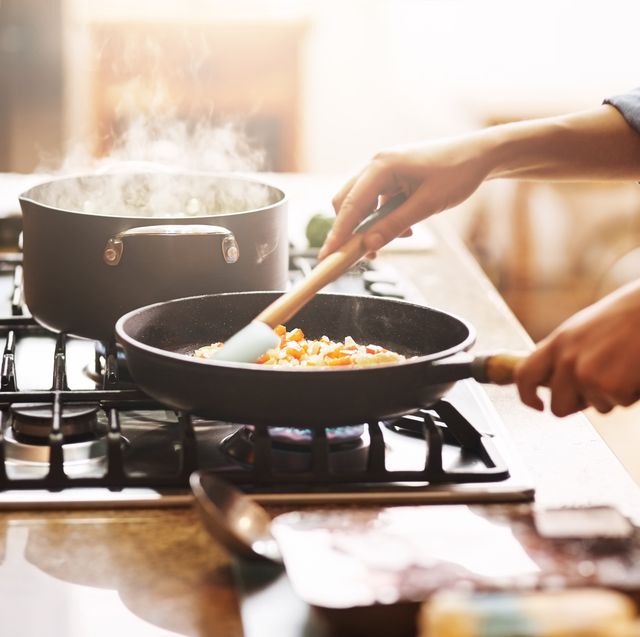
Frequently Asked Questions For Is Calphalon Cookware Safe?
Is Calphalon Cookware Safe For Health?
Yes, Calphalon cookware is safe for health as it is made from non-toxic materials that do not harm your food or release any harmful substances.
What Makes Calphalon Cookware Safe To Use?
Calphalon cookware is safe to use due to its non-stick coating, which is PFOA-free and does not release any harmful chemicals when subjected to high heat.
Can I Use Metal Utensils With Calphalon Cookware?
Yes, Calphalon cookware is designed to be durable and can withstand the use of metal utensils without scratching or damaging the surface.
Does Calphalon Cookware Leach Harmful Substances Into Food?
No, Calphalon cookware does not leach harmful substances into food, thanks to its non-reactive and non-toxic materials used in its construction.
How Should I Clean My Calphalon Cookware?
To clean your Calphalon cookware, simply wash it with warm, soapy water and a non-abrasive sponge or cloth. Avoid using harsh cleaning agents or abrasive scrubbers to maintain the longevity of the cookware.
Conclusion
Considering the various factors discussed in this blog post, it can be concluded that Calphalon cookware is generally safe to use. With its durable construction, non-stick surfaces, and adherence to safety guidelines, Calphalon provides a reliable option for cooking enthusiasts.
However, it is essential to always follow the recommended usage and maintenance instructions for the cookware to ensure its longevity and safety. With proper care, Calphalon cookware can be a valuable addition to any kitchen.


